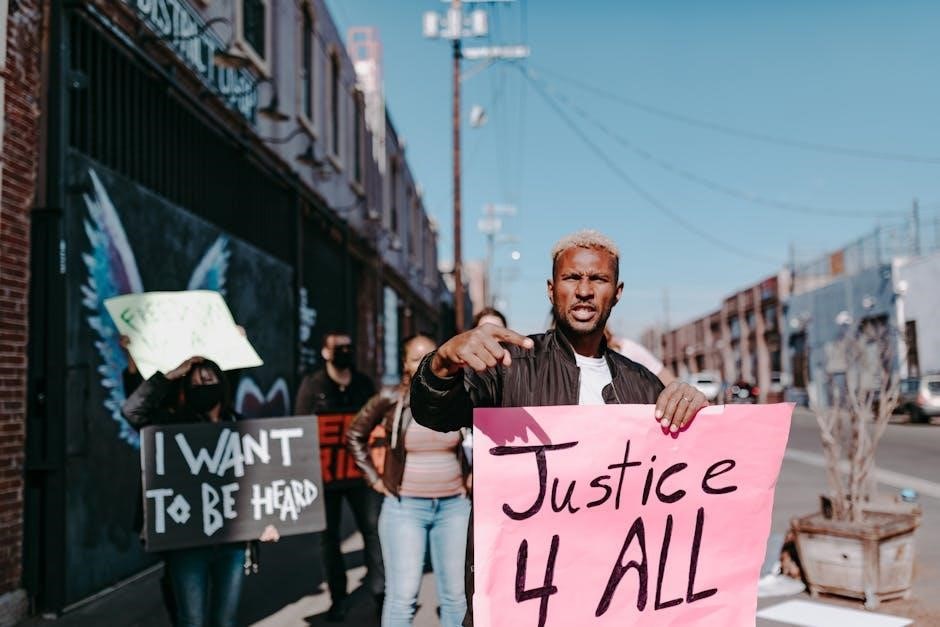Holly Madison’s memoir, Down the Rabbit Hole, reveals her journey from a small-town girl to Hugh Hefner’s girlfriend, exposing the dark truths behind Playboy’s glamorous facade.
Overview of “Down the Rabbit Hole”
Down the Rabbit Hole by Holly Madison is a gripping memoir that delves into her transformative journey from a small-town Oregon girl to Hugh Hefner’s primary girlfriend. The book, a New York Times bestseller, offers a candid look at life inside the Playboy Mansion, revealing the stark contrast between its glamorous facade and the darker realities of drugs, abuse, and manipulation. Madison’s story, published in 2015, captures her struggles with identity, power dynamics, and the psychological toll of her experiences, making it a compelling and cautionary tale about fame, trauma, and resilience.
Holly Madison’s Journey: From Small-Town Girl to Playboy Bunny
Holly Madison, born Holly Sue Cullen, transitioned from a modest upbringing in Oregon to becoming Hugh Hefner’s top girlfriend at just 21. Her spontaneous decision to enter the Playboy world reshaped her identity, catapulting her into a life of luxury and fame. However, her memoir reveals the emotional and psychological challenges she faced, including drug use, manipulation, and isolation within the mansion. Madison’s journey is a complex exploration of ambition, vulnerability, and the pursuit of a fairy-tale life that ultimately turned into a cautionary tale of power dynamics and personal resilience.
The Significance of the Memoir in Modern Pop Culture
Down the Rabbit Hole holds significant cultural weight as it challenges the romanticized view of the Playboy lifestyle, offering a raw critique of exploitation and power imbalances. Madison’s story resonates in today’s climate of feminism and #MeToo, providing a vivid account of life within the mansion. By exposing the darker realities behind the glamour, the memoir sparks conversations about consent, objectification, and the commodification of women. Its impact extends beyond personal narrative, contributing to broader discussions on gender dynamics and the often hidden costs of fame, making it a pivotal work in contemporary cultural discourse.
Holly Madison’s Early Life
Born Holly Sue Cullen in Oregon, Madison grew up in a conservative household, fostering her desire to escape and explore opportunities beyond her small-town upbringing.
Childhood in Oregon: The Making of Holly Sue Cullen
Holly Sue Cullen, later known as Holly Madison, spent her childhood in a quiet, conservative community in Oregon. Her upbringing, surrounded by family values and simplicity, shaped her early aspirations. Growing up, Holly faced challenges that fueled her desire for adventure and escape. Her parents’ influence instilled in her a sense of determination, which would later drive her to pursue opportunities beyond her small-town life. This foundation laid the groundwork for her transformation into the confident and ambitious woman she became.
The Transition from Holly Sue Cullen to Holly Madison
Holly Sue Cullen’s life took a dramatic turn at twenty-one when she adopted the name Holly Madison. This transformation marked her entry into a world of glamour and fame, as she became Hugh Hefner’s primary girlfriend. The name change symbolized her departure from a simple Oregon upbringing to a life of luxury and notoriety. Madison’s new identity was crafted to fit the Playboy image, reflecting the allure and expectations of the mansion’s lifestyle. This rebranding set the stage for her rise in the public eye, blending reality with the fantasy of her new persona.
Early Influences and Aspirations
Holly Madison’s early life in Oregon shaped her aspirations, driven by a desire to escape a challenging home environment. Her fascination with pop culture and glamour inspired her to pursue a career in entertainment. Holly’s ambition led her to Los Angeles, where she sought opportunities in modeling and acting. Her early influences included iconic figures in fashion and entertainment, fueling her vision of a glamorous lifestyle. These aspirations ultimately guided her toward the Playboy Mansion, where she hoped to find fame and stability. Her journey reflects the intersection of personal ambition and the allure of celebrity culture.
Holly Madison and Hugh Hefner
Holly Madison’s life dramatically shifted when she became Hugh Hefner’s girlfriend, entering a world of luxury and complexity that shaped her experiences and public persona.
The Spontaneous Decision That Changed Her Life
A spontaneous call at age twenty-one transformed small-town Oregon girl Holly Sue Cullen into Holly Madison, becoming Hugh Hefner’s number one girlfriend. This pivotal moment redirected her life, leading her into the Playboy Mansion’s glamorous yet troubled world. The decision, marked by both excitement and naivety, set the stage for her rise to fame and the challenges she would later face. Madison’s journey from obscurity to becoming a central figure in Hefner’s life was swift, reshaping her identity and setting the foundation for her eventual memoir, Down the Rabbit Hole. This choice became the catalyst for her complex and transformative experiences.
Life as Hugh Hefner’s Number One Girlfriend
Holly Madison’s life as Hugh Hefner’s primary girlfriend was marked by both privilege and control. She became a prominent figure in the Playboy Mansion, frequently appearing in public and on Hefner’s reality show, The Girls Next Door. While the lifestyle appeared glamorous, Madison faced intense manipulation and isolation. Hefner’s influence extended to every aspect of her life, including her appearance and behavior. The relationship was fraught with power imbalances, as Madison often felt trapped in a dynamic where her autonomy was stifled. Despite the luxury, she began to realize the emotional toll of living under Hefner’s control, setting the stage for her eventual departure.
The Dynamics of the Relationship: Power and Control
Holly Madison’s relationship with Hugh Hefner was deeply rooted in power and control. Hefner, as the patriarch of the Playboy Mansion, wielded significant influence over Madison’s life, often dictating her daily routines and appearance. This dynamic created a toxic environment where Madison felt trapped and manipulated; Hefner’s control extended to her personal life, limiting her autonomy and isolating her from the outside world. The imbalance of power became a central theme in their relationship, with Hefner exerting dominance while Madison struggled to maintain her identity. This toxic interplay of power and control ultimately contributed to Madison’s decision to leave the mansion and break free from Hefner’s grasp.

Inside the Playboy Mansion
The Playboy Mansion’s glamorous facade hid a world of drugs, sex, and abuse, where Holly Madison experienced both celebrity-studded parties and isolating manipulation behind closed doors.
The Glamorous Facade: Parties and Celebrity Encounters
The Playboy Mansion was renowned for its extravagant parties, attracting A-list celebrities and creating an illusion of luxury. Holly Madison recounts the magic of these events, where champagne flowed freely and famous faces filled the rooms. The atmosphere was electric, with themed parties and endless entertainment. However, beneath the glittering surface, these gatherings often served as distractions from the manipulative dynamics at play. Madison reveals how the mansion’s charm was a carefully crafted facade, designed to keep its residents enthralled and compliant. The allure of celebrity culture and exclusive events masked the darker realities of life inside the mansion.
The Dark Side: Drugs, Sex, and Abuse
Behind the mansion’s opulent parties, Holly Madison exposes a darker reality. She reveals the pervasive use of drugs, which were often encouraged to maintain control over the women. Sex became a tool of manipulation, with expectations placed on the girlfriends to conform to Hefner’s desires. Madison details instances of emotional and psychological abuse, where fear and isolation were used to keep the women in line. The memoir paints a harrowing picture of life under Hefner’s rule, where consent was blurred and autonomy was stripped away. This stark contrast between the mansion’s glamorous facade and its sinister underbelly is deeply unsettling.
The Isolation and Manipulation Within the Mansion
Holly Madison reveals how life inside the Playboy Mansion was marked by profound isolation and psychological manipulation. Hefner controlled every aspect of the women’s lives, dictating their routines, relationships, and even their appearances. The girlfriends were discouraged from maintaining outside friendships or pursuing personal goals, creating a culture of dependency. Madison recounts how Hefner monitored their movements, often using guilt and fear to maintain control. This isolation deepened the emotional manipulation, making it difficult for the women to escape the toxic environment.
The mansion’s seemingly luxurious setting masked a restrictive and oppressive reality, where freedom was an illusion and conformity was enforced. Madison’s account exposes the subtle yet pervasive tactics used to keep the women trapped in this gilded cage.

Holly Madison’s Exit Strategy
Holly Madison meticulously planned her departure from the Playboy Mansion, overcoming emotional and logistical challenges to break free from Hefner’s control and rebuild her life independently.
Breaking Free from the Playboy Lifestyle
Breaking free from the Playboy lifestyle was a complex and courageous journey for Holly Madison. After years of manipulation and isolation within the mansion, she realized the need to escape the toxic environment. The memoir details her emotional struggle to detach from Hugh Hefner’s control, which had deeply impacted her mental and emotional well-being. Madison faced significant challenges, including the fear of retaliation and the loss of the life she once knew. Her decision to leave marked a turning point, paving the way for her to reclaim her identity and seek a healthier, more fulfilling life outside the mansion’s oppressive walls.
The Challenges of Leaving Hugh Hefner
Leaving Hugh Hefner and the Playboy lifestyle presented immense challenges for Holly Madison. The memoir reveals her struggle to break free from Hefner’s manipulative control, which had deeply ingrained in her life. Madison faced emotional turmoil, fear of retaliation, and the daunting task of rebuilding her identity outside the mansion. The isolation she experienced made it difficult to seek support, and the loss of the life she once knew added to her anxiety. Despite these obstacles, her determination to escape the toxic relationship and regain independence drove her forward, marking a pivotal moment in her journey toward liberation and self-discovery.

Rebuilding Life After the Mansion
After leaving the Playboy Mansion, Holly Madison focused on rebuilding her life with newfound determination. She prioritized her mental health, seeking therapy to process the trauma she endured. Madison also pursued educational and career goals, distancing herself from the glamour and toxicity of her past. Her memoir became a therapeutic outlet, allowing her to share her story and inspire others. By embracing independence and authenticity, she transformed her experiences into a platform for advocacy, proving that life after the mansion could be fulfilling and meaningful. This chapter of her life highlights her resilience and commitment to personal growth.

The Writing Process
Holly Madison’s memoir, Down the Rabbit Hole, was born from her need to share raw truths about her life, offering an unfiltered look at her experiences.
Why Holly Madison Decided to Write the Memoir
Holly Madison wrote Down the Rabbit Hole to set the record straight about her life, challenging the glamorous illusions surrounding the Playboy Mansion. She sought to expose the manipulation and control she endured during her time with Hugh Hefner. By sharing her story, Madison aimed to reclaim her narrative, offering a candid look at the darker realities of her experiences. Her decision to write the memoir was driven by a desire to provide an honest account, breaking free from the myths that had defined her public persona for years. This was her way of healing and empowering others by revealing the truth.
Unveiling Secrets: The Research and Reflection
Holly Madison meticulously researched and reflected on her experiences while writing Down the Rabbit Hole. She revisited personal journals and photographs, ensuring accuracy. Madison interviewed friends and former Playboy Mansion residents to corroborate details, providing a comprehensive account. Her reflections revealed the emotional and psychological toll of her time there. The process was therapeutic yet painful, as she confronted suppressed memories. By uncovering these secrets, Madison aimed to shed light on the hidden truths behind the Playboy Mansion’s glamorous facade, offering readers a raw and unfiltered perspective on her life during that period.
The Emotional Toll of Reliving Memories
Writing Down the Rabbit Hole was emotionally draining for Holly Madison. Reliving memories of her time at the Playboy Mansion brought up buried pain and trauma. She often felt overwhelmed by the sheer intensity of past experiences, from the manipulation she endured to the toxic relationships she navigated; Madison struggled with self-doubt and anxiety, questioning whether she was ready to share such intimate details. Despite the challenges, she persisted, believing her story could empower others. The process was a mix of catharsis and struggle, ultimately contributing to her healing journey. Madison’s courage in confronting these emotions underscores the memoir’s authenticity and impact.

Publication and Reception
Down the Rabbit Hole became a New York Times bestseller upon its release in 2015. The memoir topped charts, sparking widespread interest and debate about Madison’s revelations.
The Book’s Release and Initial Reaction
Down the Rabbit Hole was released in 2015, instantly capturing media attention. Readers were drawn to its raw honesty, while critics praised its unflinching portrayal of life inside the Playboy Mansion.
Critical Acclaim and Commercial Success
Down the Rabbit Hole debuted as a New York Times bestseller, praised for its candid storytelling. Critics lauded Madison’s bravery in exposing the mansion’s darker side, resonating with readers nationwide.
Controversies Surrounding the Memoir
Madison’s memoir sparked intense debate, with some questioning its accuracy and others praising its honesty. Hugh Hefner’s team disputed her claims, while fans commended her for shedding light on hidden truths.

Themes in “Down the Rabbit Hole”
The memoir explores themes of feminism, objectification, trauma, recovery, and the allure of celebrity culture, offering a raw look into Madison’s experiences and societal impacts.
Feminism and the Objectification of Women
Holly Madison’s memoir delves into the pervasive objectification of women within the Playboy empire, shedding light on how female bodies were commodified for power and profit. Through her personal experiences, Madison highlights the exploitation inherent in the Playboy lifestyle, where women were often reduced to mere objects of desire. The book critiques the societal structures that enable such objectification, offering a feminist perspective on the broader cultural issues surrounding women’s autonomy and agency. Madison’s story serves as a cautionary tale, urging readers to recognize and challenge the systemic devaluation of women in media and society.
The Psychology of Trauma and Recovery
Holly Madison’s memoir offers a profound exploration of the psychological trauma she endured during her time in the Playboy Mansion. The book details the manipulative dynamics, emotional abuse, and isolation she faced, which deeply impacted her mental health. Madison recounts how she grappled with feelings of guilt, shame, and self-doubt, as well as the struggle to reconcile her experiences with her sense of self-worth. Her journey toward recovery is a testament to resilience, as she learns to confront the past and reclaim her identity; The memoir serves as a powerful narrative about healing, offering insights into the long-term effects of trauma and the importance of seeking validation and support.
The Allure and Dangers of Celebrity Culture
Holly Madison’s memoir vividly captures the allure of celebrity culture, detailing the glamorous parties, A-list encounters, and the intoxicating charm of the Playboy Mansion. However, she also exposes the darker side, revealing how the pursuit of fame and status led to manipulation, exploitation, and emotional turmoil. Madison’s story highlights the fragility of identity and the pressures of conforming to societal expectations. Her experiences serve as a cautionary tale, illustrating how the glittering facade of celebrity culture often hides underlying issues of control, objectification, and mental health struggles. The memoir offers a raw and unfiltered look at the true cost of fame.
Media and Cultural Impact
Holly Madison’s memoir sparked significant cultural dialogue, reshaping public perception of Hugh Hefner and the Playboy empire, while igniting conversations about feminism, exploitation, and celebrity culture’s darker truths.
The Memoir’s Influence on Pop Culture
Holly Madison’s memoir became a cultural phenomenon, sparking widespread discussions about feminism, exploitation, and the darker side of celebrity culture. Its raw honesty reshaped perceptions of the Playboy empire, humanizing the women behind the brand. The book’s success inspired others to share their stories, fostering a wave of transparency in the entertainment industry. By challenging the glamour often associated with Hugh Hefner’s world, Madison’s narrative has become a pivotal piece in the ongoing conversation about power dynamics and objectification. Its impact continues to resonate, making Down the Rabbit Hole a significant work in modern pop culture discourse.
Public Perception of Hugh Hefner and Playboy
Holly Madison’s memoir significantly altered public perception of Hugh Hefner and Playboy, revealing a reality far from the glamorous image Hefner curated. The book exposed manipulative dynamics, emotional control, and exploitation, casting doubt on the empire’s supposed liberation. Readers began questioning the objectification of women and the power imbalances within the mansion. Hefner’s legacy was reevaluated, with many viewing his influence as harmful rather than empowering. Madison’s account humanized the women involved, shifting the narrative from admiration to critique, and challenging the cultural idolization of Playboy’s founder. This shift has had lasting effects on how society views Hefner and his impact on women.
Holly Madison’s Advocacy for Women’s Rights
Holly Madison has become a prominent advocate for women’s rights, using her platform to expose exploitation and empower women. Her memoir revealed the manipulative dynamics within the Playboy Mansion, sparking conversations about consent and objectification. Madison actively supports women in sharing their stories, emphasizing the importance of autonomy and self-worth. By speaking out, she aims to dismantle the illusions surrounding the Playboy lifestyle and encourage women to recognize and escape exploitative situations. Her advocacy has resonated widely, inspiring others to seek justice and equality. Madison’s journey from survivor to advocate underscores her commitment to fostering a more equitable and supportive environment for women everywhere.
Holly Madison’s memoir offers a powerful reflection on personal growth, resilience, and the importance of speaking truth to power. Her story serves as a testament to the enduring strength of women and the need for societal change, leaving a lasting impact on readers worldwide.
Holly Madison’s Legacy Beyond the Book
Holly Madison’s legacy extends far beyond her memoir, as she continues to advocate for women’s rights and shed light on the darker side of celebrity culture. Her courage in sharing her experiences has inspired countless individuals, particularly women, to speak out against exploitation and abuse. By challenging the glorified image of the Playboy lifestyle, Madison has sparked important conversations about feminism, power dynamics, and personal resilience. Her journey from a small-town girl to a public figure has left an indelible mark on modern pop culture, proving that truth and transparency can lead to meaningful change and empowerment.
The Lasting Impact of “Down the Rabbit Hole”
Down the Rabbit Hole has left a lasting impact by challenging the romanticized narrative surrounding the Playboy lifestyle. Holly Madison’s raw honesty about her experiences has sparked critical discussions on exploitation, consent, and the objectification of women. The memoir not only shed light on the darker realities within the Playboy Mansion but also influenced public perception of Hugh Hefner and the Playboy empire. Its success has encouraged others to share their truths, fostering a cultural shift toward accountability and transparency. Madison’s story continues to resonate, serving as a powerful reminder of the importance of personal resilience and the need for societal change.
A Call to Action: Learning from Holly’s Story
Holly Madison’s memoir serves as a powerful call to action, urging readers to reflect on the societal structures that enable exploitation. Her story highlights the importance of empathy, self-awareness, and the need to challenge toxic systems. By sharing her journey, Madison encourages women to recognize their worth and resist objectification. Her resilience offers hope and inspiration, showing that it’s never too late to seek a better life. Readers are prompted to advocate for change, supporting those affected by similar experiences and fostering a culture of respect and equality. Madison’s story is a testament to the strength of the human spirit and the power of speaking out.



